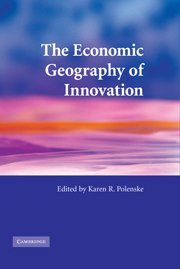Book contents
- Frontmatter
- Contents
- List of figures
- List of tables
- Notes on contributors
- Acknowledgments
- Abstracts
- List of abbreviations and acronyms
- Part I Concepts and measurements in innovation
- Part II Institutional and spatial aspects of information and knowledge flows
- Part III Institutions and innovation systems
- 10 National systems of production, innovation, and competence building
- 11 Perspectives on entrepreneurship and cluster formation: biotechnology in the US Capitol region
- 12 Facilitating enterprising places: the role of intermediaries in the United States and United Kingdom
- 13 Innovation, integration, and technology upgrading in contemporary Chinese industry
- 14 Society, community, and development: a tale of two regions
- Index
- References
11 - Perspectives on entrepreneurship and cluster formation: biotechnology in the US Capitol region
Published online by Cambridge University Press: 22 September 2009
- Frontmatter
- Contents
- List of figures
- List of tables
- Notes on contributors
- Acknowledgments
- Abstracts
- List of abbreviations and acronyms
- Part I Concepts and measurements in innovation
- Part II Institutional and spatial aspects of information and knowledge flows
- Part III Institutions and innovation systems
- 10 National systems of production, innovation, and competence building
- 11 Perspectives on entrepreneurship and cluster formation: biotechnology in the US Capitol region
- 12 Facilitating enterprising places: the role of intermediaries in the United States and United Kingdom
- 13 Innovation, integration, and technology upgrading in contemporary Chinese industry
- 14 Society, community, and development: a tale of two regions
- Index
- References
Summary
Introduction
Two decades ago, Gaithersburg, Frederick, and Rockville, Maryland, were largely commuter communities for US federal government employees. Today, these Washington suburbs host one of the most dynamic and fast-growing biotechnology (biotech) clusters in the United States (Ernst and Young 2001). While analysts have well documented the tendency for an innovative industry to cluster spatially, they have not answered questions about the development of regional industrial clusters, and the role government policy plays in cluster formation and sustainability. In this chapter, I focus on the emergence of a biotech cluster in the Capitol region.
Based on extensive interviews, I posit that three exogenous sets of factors sparked the nascent entrepreneurial talent in the region, creating the sufficient conditions for the emergence of a biotech cluster: (1) pre-existing resources, (2) entrepreneurship and incentives, and (3) infrastructure provided by government. This emergence was hastened by a series of exogenous events that lowered the opportunity cost of entrepreneurship and promoted the formation of new ventures. Although these changes were national policy initiatives, the Capitol region was in a unique position to capture the benefits. State government policies targeted at the biotech industry reinforced rather than led the cluster formation. My hypothesis is that entrepreneurs and new-firm formation are critical elements in the development of innovative clusters, and occur in those places at a time when the preconditions and incentives are supportive.
To support this hypothesis, I document some of the public initiatives that provided resources for the developing Maryland cluster in Section 11.2.
- Type
- Chapter
- Information
- The Economic Geography of Innovation , pp. 241 - 260Publisher: Cambridge University PressPrint publication year: 2007
References
- 10
- Cited by



